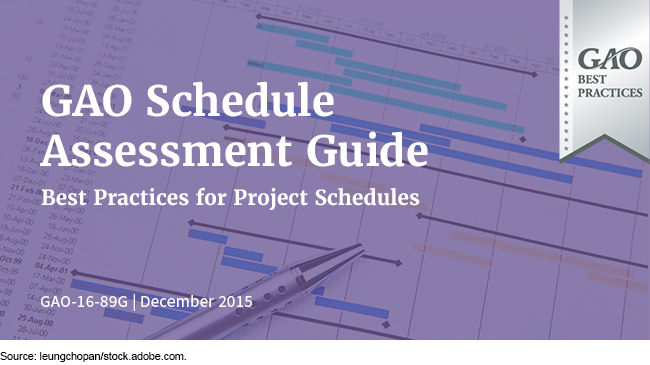GAO Schedule Assessment Guide: Best Practices for Project Schedules
Highlights
The U.S. Government Accountability Office is responsible for, among other things, assisting the Congress in its oversight of the federal government, including agencies' stewardship of public funds. To use public funds effectively, the government must employ effective management practices and processes, including the measurement of government program performance.
Toward these objectives, in March 2009, we published the GAO Cost Estimating and Assessment Guide as a consistent methodology based on best practices that can be used across the federal government to develop, manage, and evaluate capital program cost estimates. The methodology outlined in the Cost Estimating and Assessment Guide is a compilation of best practices that federal cost estimating organizations and industry use to develop and maintain reliable cost estimates throughout the life of an acquisition program.
This schedule guide is a companion to the Cost Guide. A cost estimate cannot be considered credible if it does not account for the cost effects of schedule slippage. An effective methodology for developing, managing, and evaluating capital program cost estimates includes the concept of scheduling the necessary work to a timeline, as discussed in the Cost Guide. Typically, schedule variances are followed by cost variances and management tends to respond to schedule delays by adding more resources or authorizing overtime. Therefore, a reliable schedule can contribute to an understanding of the cost impact if the program does not finish on time. Further, a schedule risk analysis allows for program management to account for the cost effects of schedule slippage when developing the life-cycle cost estimate.
Thus, a well-planned schedule is a fundamental management tool that can help government programs use public funds effectively by specifying when work will be performed in the future and measuring program performance against an approved plan. Moreover, as a model of time, an integrated and reliable schedule can show when major events are expected as well as the completion dates for all activities leading up to them, which can help determine if the program's parameters are realistic and achievable.
Additionally, a well-formulated schedule can facilitate an analysis of how change affects the program. Accordingly, a schedule can serve as a warning that a program may need an overtarget budget or schedule.
The GAO Schedule Assessment Guide develops the scheduling concepts introduced in the Cost Estimating and Assessment Guide and presents them as ten best practices associated with developing and maintaining a reliable, high-quality schedule. The GAO Schedule Assessment Guide also presents guiding principles for auditors to evaluate certain aspects of government programs.

The Schedule Assessment Guide is also available in a digital format.
